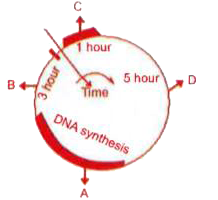Giant mammals became extinct during
(a) Pleiostocene-holecene
(b) Pliocene-pleistocene
(c) Eocene-oligocene
(d) Pliocene-miocene
Pleiostocene-holecene
Pliocene-pleistocene
Eocene-oligocene
Pliocene-miocene
The correct Answer is:A
To solve the question regarding the extinction of giant mammals, we need to analyze the options provided and determine the correct time period in which these extinctions occurred. Here’s a step-by-step breakdown:
Step 1: Understand the Question
The question asks about the time period during which giant mammals became extinct. We need to identify the correct geological epoch from the options given.
Step 2: Review the Options
The options provided are:
- (a) Pleistocene-Holocene
- (b) Pliocene-Pleistocene
- (c) Eocene-Oligocene
- (d) Pliocene-Miocene
Step 3: Identify the Extinction Period
Giant mammals, often referred to as megafauna, are known to have gone extinct around 10,000 to 12,000 years ago. This timeframe corresponds to the end of the last Ice Age, which is primarily associated with the Pleistocene epoch.
Step 4: Analyze Each Option
- Option (a) Pleistocene-Holocene: This period includes the end of the Pleistocene and the beginning of the Holocene, which aligns with the extinction of giant mammals.
- Option (b) Pliocene-Pleistocene: The Pliocene precedes the Pleistocene, and while some extinctions may have occurred, the major extinction event for giant mammals is more closely associated with the Pleistocene.
- Option (c) Eocene-Oligocene: This period is much earlier than the extinction of giant mammals and is therefore incorrect.
- Option (d) Pliocene-Miocene: Similar to option (b), this period does not correspond with the extinction of giant mammals.
Step 5: Conclusion
Based on the analysis, the correct answer is (a) Pleistocene-Holocene. This is the period during which the giant mammals became extinct.
Final Answer
(a) Pleistocene-Holocene
---
The question asks about the time period during which giant mammals became extinct. We need to identify the correct geological epoch from the options given.
The options provided are:
- (a) Pleistocene-Holocene
- (b) Pliocene-Pleistocene
- (c) Eocene-Oligocene
- (d) Pliocene-Miocene
Giant mammals, often referred to as megafauna, are known to have gone extinct around 10,000 to 12,000 years ago. This timeframe corresponds to the end of the last Ice Age, which is primarily associated with the Pleistocene epoch.
- Option (a) Pleistocene-Holocene: This period includes the end of the Pleistocene and the beginning of the Holocene, which aligns with the extinction of giant mammals.
- Option (b) Pliocene-Pleistocene: The Pliocene precedes the Pleistocene, and while some extinctions may have occurred, the major extinction event for giant mammals is more closely associated with the Pleistocene.
- Option (c) Eocene-Oligocene: This period is much earlier than the extinction of giant mammals and is therefore incorrect.
- Option (d) Pliocene-Miocene: Similar to option (b), this period does not correspond with the extinction of giant mammals.
Based on the analysis, the correct answer is (a) Pleistocene-Holocene. This is the period during which the giant mammals became extinct.
(a) Pleistocene-Holocene
Topper's Solved these Questions
- HUMAN EVOLUTIONBOOK - DINESH PUBLICATION ENGLISHCHAPTER - HUMAN EVOLUTIONEXERCISE - Check Your Grasp
10 Videos
- GROWTH, REPAIR, REGENERATION AND AGEINGBOOK - DINESH PUBLICATION ENGLISHCHAPTER - GROWTH, REPAIR, REGENERATION AND AGEINGEXERCISE - Brain Teasers-VI[B]
6 Videos
- HUMAN HEALTH AND DISEASEBOOK - DINESH PUBLICATION ENGLISHCHAPTER - HUMAN HEALTH AND DISEASEEXERCISE - CHECK YOUR GRASP
17 Videos
Similar Questions
Knowledge Check
When a species becomes extinct, the plant and animal species associated with it in an obligatory way also become extinct. This phenomenon is referred to as
(a) fragmentation
(b) alien species invasion
(c) over-exploitation
(d) co-extinctionAfragmentationBalien species invasionCover-exploitationDco-extinctionThe maximum growth rate is observed during
(a) lag phase
(b) log phase
(c) stationary phase
(d) senescenceAlag phaseBlog phaseCstationary phaseDsemescenceAnimals undergoing inactive stage during winter is known as
(a) aestivation
(b) hibernation
(c) adaptation
(d) acclimatizationAaestivationBhibernationCadaptationDacclimatization
Archaeopteryx lived during
(a) Cretaceous
(b) Triassic
(c) Permian
(d) Jurassic
View SolutionChromosomes can be seen best during
(a) Prophase stage
(b) Metaphase
(c) Anaphase I
(d) Telophase I
View SolutionGas released during bhopal tragedy was
(a) methyl isocyanate
(b) potassium isothiocyanate
(c) sodium isothiocynate
(d) ethyl isothiocyanate
View SolutionDodo, passenger pigeon and Steller's sea cow became extinct in the last 500 years due to
(a) Habitat destruction
(b) Over-exploitation
(c) Bird-flu virus infection
(d) Pollution
View SolutionAnimals which excrete urea produced during metabolism of amino acids is
(a) ureotelism
(b) uricotelism
(c) ammonotelism
(d) aminotelism
View Solution

